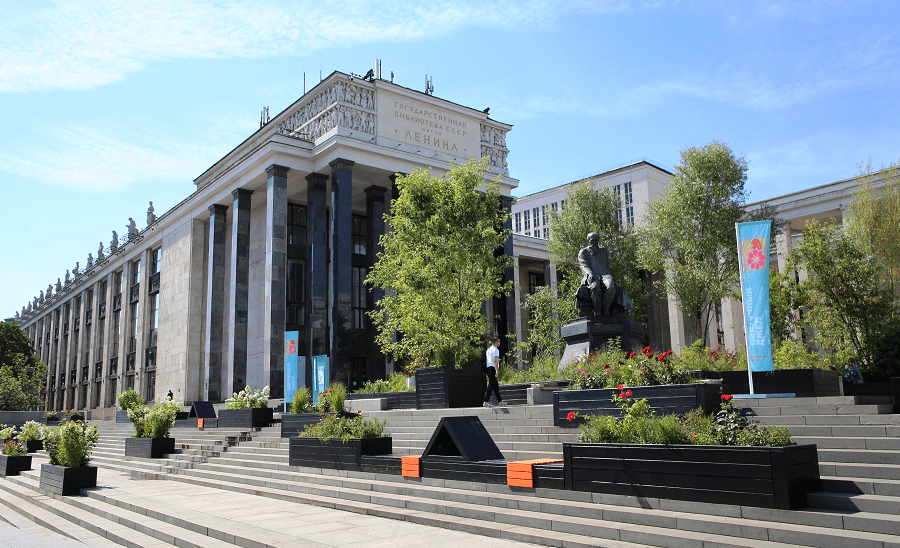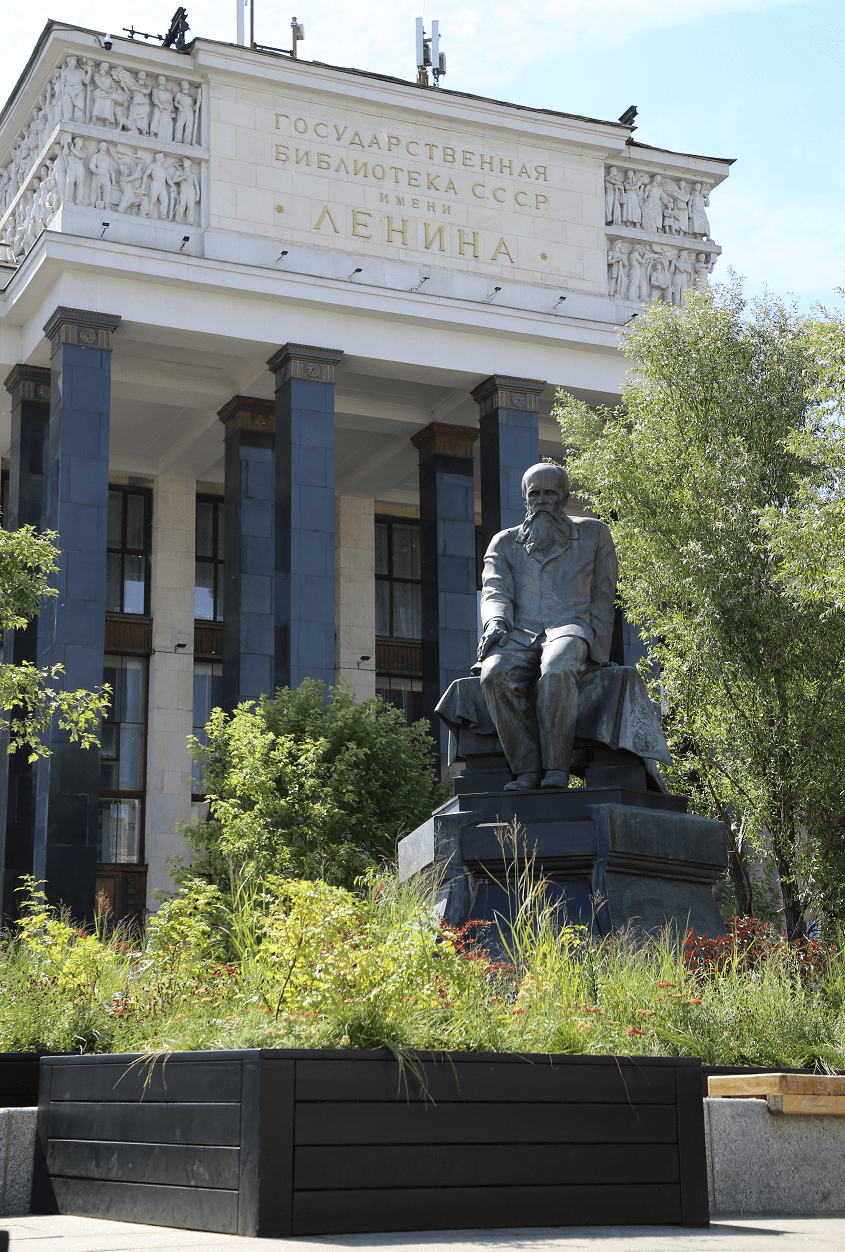The Russian State Library (FGBU RSL) is the national library of the Russian Federation, the largest public library in Russia and continental Europe and one of the largest libraries in the world, located in Moscow; a leading research institution in the field of library science, bibliography and book science, a methodological and advisory centre for Russian libraries of all systems (except for special and scientific and technical ones), a centre for recommendatory bibliography.
It was founded on June 19 (July 1), 1862 as part of the Moscow Public Museum and the Rumyantsev Museum. Since its formation, it has received mandatory copies of domestic publications. January 24, 1924, renamed the Russian Library named after V. I. Lenin. On February 6, 1925, it was transformed into the State Library of the USSR named after V. I. Lenin, and since January 22, 1992, it has had its modern name.
The original Rumyantsev Museum, founded in 1831 in St. Petersburg, has been part of the Imperial Public Library since 1845. The museum was in a state of disrepair. The curator of the Rumyantsev Museum, V. F. Odoevsky offered to transport the Rumyantsev collections to Moscow, where they would be in demand and preserved. In 1861, the acquisition and organization of funds and the transfer of the Rumyantsev collections from St. Petersburg to Moscow began.
Library building complex
The complex of buildings of the Russian State Library is located in the historic district of Staroe Vagankovo, in the White City of Moscow. It includes the main building with a 19-tier book depository and the Pashkov House.
With the transformation of the Library of the State Rumyantsev Museum into the State Library of the USSR, V. I. Lenin, with a huge number of book receipts and high status, demanded innovation. First, the expansion of space. In 1926, the Council of People’s Commissars of the USSR recognized “the existing building of the Lenin Library as inappropriate for its work and significance.”
In 1927-1929, a competition for the best project was held in three stages. Preference was given to the project of architects V. G. Gelfreikh and V. A. Shchuko, although they did not participate in the competition. The Director of the Library V. I. Nevsky appreciated their work.
It became the standard of “Stalin’s Empire”. The authors combined Soviet monumentalism and neoclassical forms. The building has been harmoniously installed into the architectural environment – the Kremlin, Moscow University, the Manege and the Pashkov House.
The building is lavishly decorated. Between the pylons of the facade, there are bronze bas-reliefs depicting scientists, philosophers, and writers: Archimedes, Copernicus, Galileo, I. Newton, M. V. Lomonosov, Ch. Darwin, A. S. Pushkin, N. V. Gogol. The sculptural frieze above the main portico was made mainly according to the drawings of the academician of architecture and theatrical artist V. A. Shchuko. M. G. Manizer, N. V. Krandievskaya, V. I. Mukhina, S. V. Evseev and V. V. Lishev also participated in the design of the library. The architect A.F. Khryakov designed the conference hall.
Limestone and solemn black granite were used for facade cladding, and marble, bronze and oak wall panels were used for interiors. The construction of the first phase of the complex continued until 1941.
In the late 1930s, a 19-tier book depository was built, with a total area of almost 85,000 m². Between the tiers of the vault, a lattice grid is laid, allowing the building to withstand the full weight of millions of books.
On May 15, 1935, one of the first stations of the Moscow metro was opened near the library and was called Biblioteka imeni Lenina.
In 1957-1958, the construction of buildings “A” and “B” was completed. The general construction and development lasted until 1960.
As of January 1, 2017, the volume of RSL funds amounted to 46.9 million accounting units; the funds included 18.7 million books and brochures, 13.3 million issues of magazines, 739.6 thousand annual sets of newspapers, 379.1 thousand units of notes, 154.8 thousand maps, 1.3 million isographic units, 1 million units of sheet text publications, 2.3 million units of special types of technical publications, 1088.8 thousand dissertations, 605.6 thousand units of archival and manuscript materials, 11.5 thousand unpublished materials on culture and art, 37.9 thousand audio-visual documents, 3.3 million rolls of microfilms, 60.9 thousand CDs, 1237.2 thousand electronic documents.
The Manuscript Fund is a universal collection of written and graphic manuscripts in different languages, including Old Russian, Ancient Greek, and Latin. It contains handwritten books, archival collections and funds, and personal (family and tribal) archives. The documents, the earliest of which date back to the 6th century AD. e., are made on paper, parchment and other specific materials. The fund contains the rarest handwritten books: the Arkhangelsk Gospel (1092) and the Khitrovo Gospel (late 14th – early 15th centuries).
The fund of rare and valuable publications has more than 300 thousand items. It includes printed publications in Russian and in foreign languages, corresponding to certain social and value parameters – uniqueness, priority, memorableness and collectability. The Fund, according to the content of the documents included in it, is universal. It presents printed books from the middle of the 16th century, Russian periodicals, including Moskovskiye Vedomosti (from 1756), and publications of the Slavic pioneers Sh. Fiol, F. Skorina, I. Fedorov and P. Mstislavets, collections of incunabula and paleotypes, the first editions of the works of J. Bruno, Dante, R. G. de Clavijo, N. Copernicus, archives of N. V. Gogol, I. S. Turgenev, A. P. Chekhov, A. A. Blok, M. A. Bulgakov and others.
As of January 1, 2017, about 96.9 thousand readers, who received up to 13.9 million documents annually, used the Library’s information resources. 12.6 million Russian and foreign users visit the RSL every year. Their information service is conducted in 36 reading rooms with 1748 seats (of which 368 are computerized). 11.6 million users visited the library websites in 2016.
Nearest metro: Arbatskaya (Filyovskaya Line), Arbatskaya (Arbatsko-Pokrovskaya line), Biblioteka imeni Lenina.
Nearest attractions: Arbat street, New Arbat Avenue, Church of Simeon Stolpnik on Povarskaya, Khudozhestvenny cinema, Arseny Morozov’s mansion, Shakhovsky – Krause – Osipovsky’s mansion, Shchusev State Museum of Architecture, Razumovsky-Sheremetev House, Vozdvizhenka Street, Gogol boulevard.
See also Architecture of Moscow, Palaces and most historic buildings of Moscow.













